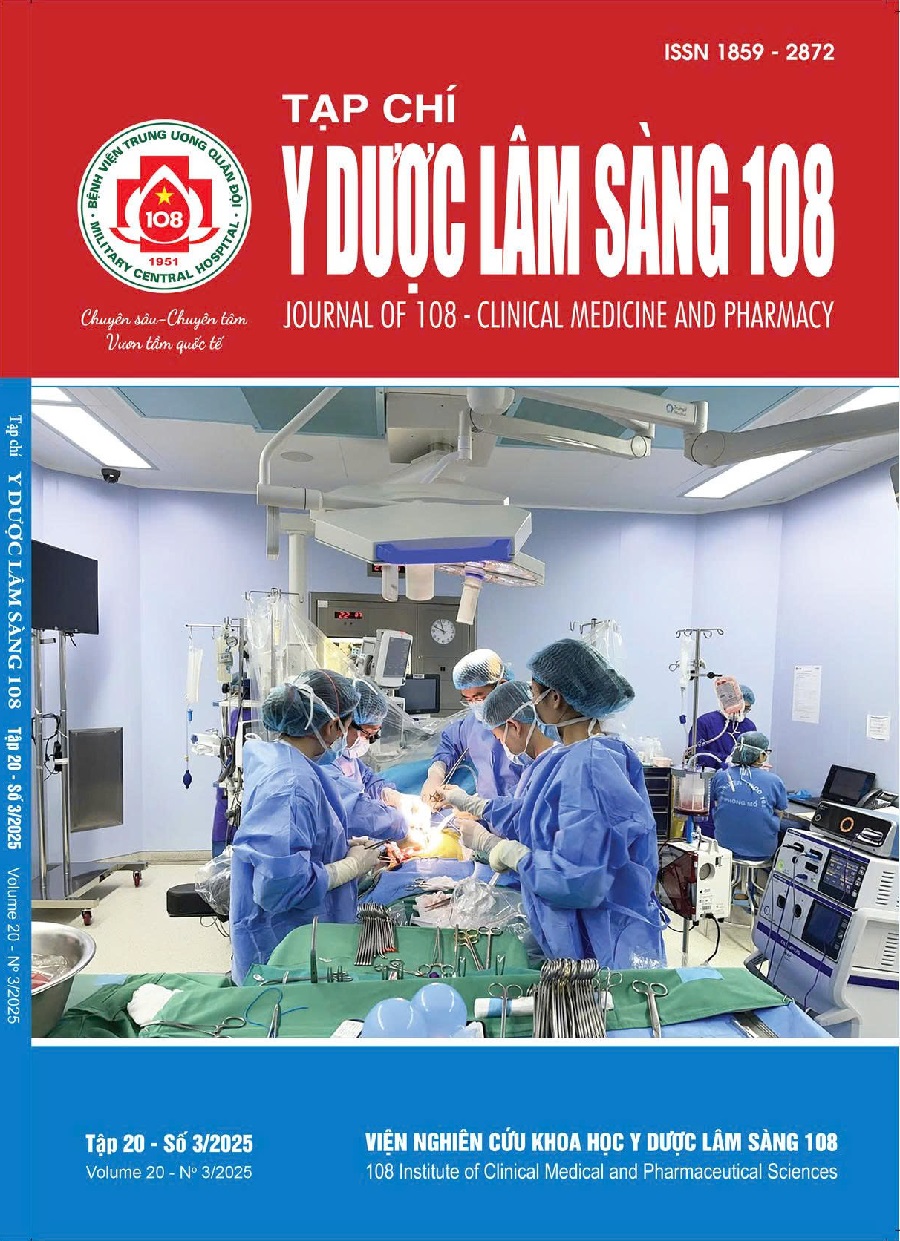Evaluate the value of urinary L-FABP in predicting the severity of acute kidney injury in patients with sepsis and septic shock
Main Article Content
Keywords
Abstract
Objective: To evaluate the value of urinary L-FABP in predicting the severity of acute kidney injury (AKI) in patients with sepsis and septic shock. Subject and method: A prospective descriptive study conducted on 212 patients with sepsis and septic shock at 108 Military Central Hospital. Result: Urinary L-FABP concentration was significantly higher in patients with more advanced stages of acute kidney injury (AKI), with values of 44.26 (11.50-203.61) µg/gCre for stage 3, 32.56 (22.52-53.55) µg/gCre for stage 2, and 21.30 (16.71-53.87) µg/gCre for stage 1, respectively (p<0.001). At a urinary L-FABP cut-off point of 21.5 µg/gCre, it demonstrated a predictive value for severe AKI, exhibiting a sensitivity of 72.7% and specificity of 68.2%, with p<0.01 and AUC = 0.73. Conclusion: Urinary L-FABP had prognostic value in assessing the severity of acute kidney injury in patients with sepsis and septic shock. A urinary L-FABP cutoff of ≥ 21.5µg/g creatinine predicted severe acute kidney injury with a sensitivity of 72.7%, specificity of 68.2%, and an AUC of 0.73.
Article Details
References
2. Xu Y, Xie Y, Shao X, Ni Z, Mou S (2015) L-FABP: A novel biomarker of kidney disease. Clin Chim Acta. 445: 85-90. doi:10.1016/j.cca.2015.03.017.
3. Doi K, Nishida O, Shigematsu T et al The Japanese clinical practice guideline for acute kidney injury 2016. Clinical and experimental nephrology (5): 985-1045. doi:10.1007/s10157-018-1600-4.
4. Singer M, Deutschman CS, Seymour CW et al (2016) The Third International Consensus Definitions for Sepsis and Septic Shock (Sepsis-3). Jama 315(8):801-10. doi:10.1001/jama.2016.0287.
5. Khwaja A (2012) KDIGO clinical practice guidelines for acute kidney injury. Nephron Clin Pract 120(4):c179-184. doi: 10.1159/000339789.
6. Watchorn J, Huang D, Hopkins P, Bramham K (2019) Prospective longitudinal observational study of the macro and micro haemodynamic responses to septic shock in the renal and systemic circulations: A protocol for the MICROSHOCK - RENAL study. BMJ Open 9(8):e028364. doi:10.1136/bmjopen-2018-028364.
7. Sun T, Qu S, Huang T et al (2021) Rapid and sensitive detection of L-FABP for prediction and diagnosis of acute kidney injury in critically ill patients by chemiluminescent immunoassay. J Clin Lab Anal 35(11):24051. doi:10.1002/jcla.24051.
8. Hartomuljono A, Salahuddin A, Amin H et al (2021) The Role of Urine Liver Fatty Acid Binding Protein in Early Detection of Acute Kidney Injury in Septic Patient. Egyptian Journal of Critical Care Medicine. 8(4):114-117. doi:10.1097/ej9.0000000000000019.
9. Peerapornratana S, Manrique-Caballero CL, Gómez H, Kellum JA (2019) Acute kidney injury from sepsis: current concepts, epidemiology, pathophysiology, prevention and treatment. Kidney Int 96(5):1083-1099. doi:10.1016/j.kint.2019.05.026.
10. Parr SK, Clark AJ, Bian A et al (2015) Urinary L-FABP predicts poor outcomes in critically ill patients with early acute kidney injury. Kidney Int 87(3):640-648. doi:10.1038/ki.2014.301.
11. Ferguson MA, Vaidya VS, Waikar SS et al (2010) Urinary liver-type fatty acid-binding protein predicts adverse outcomes in acute kidney injury. Kidney international 77(8):708-14. doi:10.1038/ki.2009.422.
 ISSN: 1859 - 2872
ISSN: 1859 - 2872
